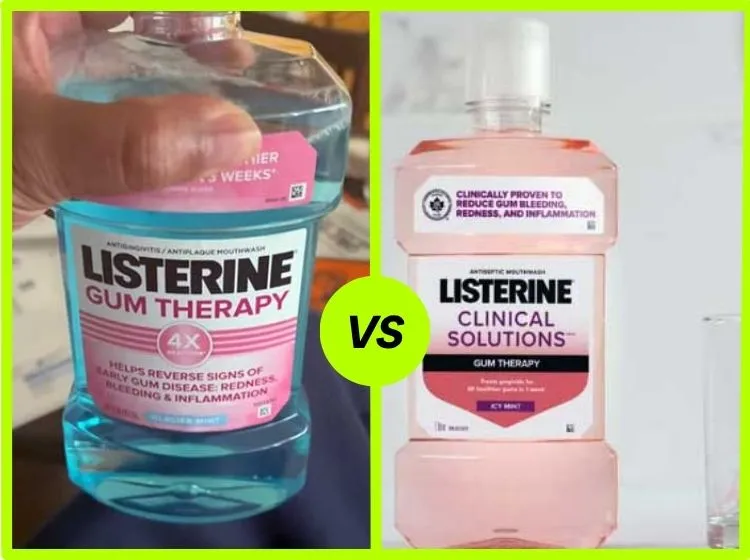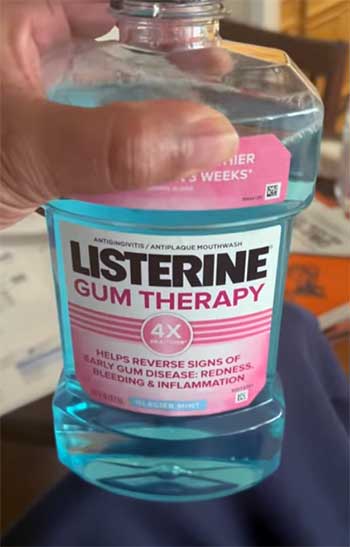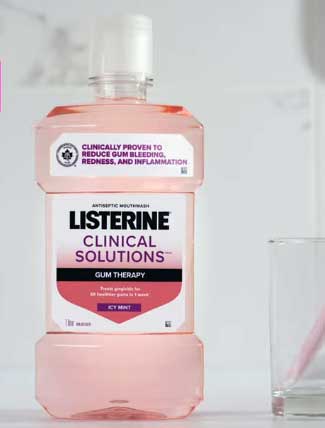I’ve always taken my oral health seriously, but when my gums started bleeding during brushing, I knew it was time to level up my routine.
Listerine Gum Therapy and Listerine Clinical Solutions caught my eye—two mouthwashes promising healthier gums. In this 3200-word article, I’ll share my real-world experience comparing these products, breaking down their pros, cons, and key features in a conversational, easy-to-understand way. My goal is to help you decide which mouthwash fits your gum health needs, backed by an analytical perspective and a handy comparison table.

A Brief Comparison Table
| Feature | Listerine Gum Therapy | Listerine Clinical Solutions Gum Health |
| Primary Focus | Anti-plaque, anti-gingivitis | Advanced gingivitis treatment, plaque reduction |
| Key Ingredients | Essential oils (eucalyptol, menthol, methyl salicylate, thymol) | Essential oils, 67% more zinc chloride |
| Alcohol Content | Contains alcohol | Contains alcohol |
| Flavor | Glacier Mint | Icy Mint |
| ADA Acceptance | Yes | Yes |
| Claimed Benefits | Reverses early gingivitis, reduces plaque | 3x healthier gums in 1 week, 64% less gum bleeding |
| Usage | Twice daily, 20 mL for 30 seconds | Twice daily, 20 mL for 30 seconds |
| Price (1L) | ~$7–$9 | ~$8–$10 |
| Best For | Early gingivitis, budget-conscious users | Moderate gingivitis, advanced gum care |
My Gum Health Wake-Up Call
A few months back, I noticed my gums looking redder than usual. Brushing became a gamble—would I see blood in the sink again? My dentist diagnosed mild gingivitis, a common issue caused by plaque irritating the gums.
She urged me to enhance my oral hygiene, specifically with a gum-focused mouthwash. I turned to Listerine, a brand I’d trusted for fresh breath but hadn’t explored for gum care. Two products stood out: Listerine Gum Therapy and Listerine Clinical Solutions Gum Health. Both sounded promising, but which was better for me? I decided to try them both and share what I learned.
Understanding Listerine Gum Therapy
Listerine Gum Therapy, with its cool Glacier Mint bottle, is marketed as an anti-plaque and anti-gingivitis mouthwash. It’s part of Listerine’s core lineup, aimed at tackling early gum disease and keeping plaque under control.

The first thing that hit me was the classic Listerine burn—yep, it’s alcohol-based, delivering that signature zing. Its active ingredients are four essential oils: eucalyptol, menthol, methyl salicylate, and thymol.
These work together to kill germs causing plaque and gingivitis, and the American Dental Association (ADA) endorses its effectiveness for reducing gingivitis and plaque above the gumline.
Using it was simple: rinse with 20 mL for 30 seconds, twice daily after brushing.
The Glacier Mint flavor was crisp, leaving my mouth feeling clean, though the alcohol sting took some getting used to.
After a week, I noticed less bleeding when brushing—a huge relief.
My gums felt less tender, and the redness began to fade. It wasn’t an overnight fix, but it definitely stabilized things.
Pros of Listerine Gum Therapy
- Effective for Early Gingivitis: The essential oils hit hard, reducing plaque and reversing early gingivitis signs like bleeding and inflammation. My gums felt better within days.
- ADA Seal of Approval: The ADA’s endorsement gave me confidence in its safety and efficacy.
- Affordable: At $7–$9 for a 1-liter bottle, it’s easy on the wallet for daily use.
- Widely Available: I found it at every drugstore and online, making restocking a breeze.
- Fresh Breath Bonus: The Glacier Mint flavor doubles as a breath freshener, leaving my mouth minty fresh.
Cons of Listerine Gum Therapy
- Alcohol Burn: The alcohol can be intense, especially for sensitive gums or dry mouths. It stung more than I’d prefer.
- Limited Advanced Features: It’s solid for early gingivitis but lacks specialized ingredients for more severe gum issues.
- No Zinc: Unlike Clinical Solutions, it doesn’t have zinc chloride, which may limit its ability to shift the oral microbiome for advanced care.
- Lingering Taste: The strong mint flavor can stick around, sometimes clashing with food or drinks post-rinse.
Exploring Listerine Clinical Solutions Gum Health
Next up was Listerine Clinical Solutions Gum Health, which felt like the premium choice. This mouthwash boasts a more advanced formula, with 67% more zinc chloride than other Listerine products, alongside the same essential oils as Gum Therapy.

It’s pitched as a powerhouse for gingivitis, claiming 3x healthier gums in one week and a 64% reduction in gum bleeding.
The Icy Mint flavor was bold yet slightly smoother than Gum Therapy’s bite.
The usage was identical: 20 mL, 30 seconds, twice daily. What struck me was how fast it worked.
After three days, my gums bled less, and by week’s end, they looked healthier—less red and swollen.
The zinc chloride made a difference, as my dentist later explained it helps shift the oral microbiome by targeting subgingival bacteria.
The ADA approves this one too, and clinical studies back its claims, boosting my trust in it.
Pros of Listerine Clinical Solutions
- Advanced Formula: The zinc chloride targets subgingival bacteria, making it more effective for moderate gingivitis.
- Fast Results: I saw reduced bleeding and inflammation in days, with major improvements in a week.
- ADA and Clinical Backing: Rigorous studies and ADA approval make it a reliable pick for gum health.
- Smoother Flavor: The Icy Mint was slightly less harsh than Gum Therapy, despite the alcohol.
- Long-Term Benefits: It claims to maintain healthy gums for up to 12 weeks with consistent use, ideal for ongoing care.
Cons of Listerine Clinical Solutions
- Higher Price: At $8–$10 per liter, it’s pricier than Gum Therapy, which can add up over time.
- Alcohol Sting: The alcohol can still irritate sensitive mouths or worsen dryness.
- Not for Severe Cases: It’s great for gingivitis but won’t cure advanced gum disease like periodontitis.
- Limited Availability: It’s not as common as Gum Therapy; I had to order it online at times.
My Experience Comparing the Two
Switching between these mouthwashes felt like test-driving two cars—one’s a dependable sedan, the other’s a sleek sports car with extra features.
Gum Therapy was my first choice because it was cheaper and easier to find. It worked well for my mild gingivitis, cutting down on bleeding and keeping my breath fresh. But when my symptoms lingered, I tried Clinical Solutions, and the difference was clear.
The zinc chloride tackled deeper gum issues, and my dentist confirmed my gums looked healthier at my follow-up. The alcohol burn was a downside for both.
I have friends with sensitive mouths who avoid alcohol-based rinses, and I understand why—it can feel like a fire if your gums are already sore. Clinical Solutions felt more “clinical,” like it was working harder behind the scenes. Gum Therapy was reliable but seemed more like a general rinse with gum benefits, while Clinical Solutions was laser-focused on gingivitis.
Key Features Breakdown
Let’s break down what makes these two different. Gum Therapy leans on its essential oils to kill 99.9% of plaque- and gingivitis-causing germs. It’s a straightforward formula, perfect for early-stage issues.
Clinical Solutions adds zinc chloride, which not only kills germs but also shifts the oral microbiome to reduce subgingival bacteria. This makes it better for moderate cases or those wanting faster results.
Both are ADA-accepted, meaning they’ve been rigorously tested for safety and efficacy. They share the same usage protocol, so your routine stays simple.
The flavors—Glacier Mint vs. Icy Mint—are similar, but I found Clinical Solutions less aggressive. Price-wise, Gum Therapy is the budget pick, but Clinical Solutions justifies its cost with quicker, more targeted results.
When to Choose Gum Therapy
I’d recommend Gum Therapy for early gingivitis or prevention. It’s ideal for budget-conscious folks or those wanting a no-frills mouthwash.
If your gums bleed occasionally but aren’t a major problem, this is your go-to. It’s also great if you’re a Listerine fan and want something familiar that doubles as a breath freshener.
When to Choose Clinical Solutions
Clinical Solutions is my choice for moderate gingivitis or persistent symptoms like bleeding and inflammation. The zinc chloride gives it an edge, especially for quicker results or a history of gum issues.
It’s worth the extra cost for an advanced formula backed by studies. Just be ready to search online or at bigger stores to find it.
The Science Behind the Claims
I looked into the science to see if these products live up to their promises. Listerine cites studies showing Gum Therapy reduces plaque and gingivitis when paired with brushing and flossing.
Clinical Solutions goes further, with research like the 2023 IADR study showing its zinc chloride formula cuts subgingival bacteria and improves gum health faster than brushing alone. The 64% reduction in gum bleeding claim for Clinical Solutions was real for me—my sink stayed blood-free sooner than with Gum Therapy.
That said, both have limits. Neither can cure periodontitis, the severe form of gum disease. My dentist emphasized that mouthwash is a supplement, not a substitute for brushing, flossing, and cleanings.
If your gums are receding or teeth feel loose, see a dentist—don’t just rinse and hope.
The Alcohol Debate
The alcohol in both is a mixed bag. It helps the essential oils penetrate plaque and kill germs faster, but it can irritate sensitive gums or dry out your mouth.
I didn’t mind the burn much, but it’s not for everyone. If you have dry mouth or hate the sting, alcohol-free options like CloSYS might be worth exploring, though they may not pack the same germ-killing punch.
Cost vs. Value
On a tight budget? Gum Therapy wins at $7–$9 per liter. It’s effective for basic gum care and easy to find.
Clinical Solutions, at $8–$10, feels like an investment, but its faster results and advanced formula justify the cost for stubborn gum issues. I paid more for Clinical Solutions during flare-ups but switched to Gum Therapy for maintenance.
Real-World Usage Tips
Using these mouthwashes taught me a few tricks. First, don’t rinse with water right after—you’ll dilute the active ingredients. I also found morning and night rinsing worked best, after brushing and flossing.
If the burn’s too much, try diluting with a tiny bit of water (though this might reduce efficacy). Keep the bottle out of reach of kids—both have alcohol and aren’t safe for swallowing.
Combining with Other Oral Care
Mouthwash alone won’t cut it. I paired both with a soft-bristle toothbrush, fluoride toothpaste, and daily flossing. My dentist also suggested a water flosser for hard-to-reach spots, which made a big difference.
Regular cleanings every six months kept my gingivitis in check. Think of mouthwash as the cherry on top of a solid oral care routine.
Read More: Hum vs. Oral-B
What My Dentist Said
I checked in with my dentist after using both products. She was impressed with my progress, especially with Clinical Solutions, noting my gums looked less inflamed.
She explained that zinc chloride’s ability to target subgingival bacteria gives Clinical Solutions an edge for moderate cases. However, she cautioned that neither replaces professional care for advanced issues. Her advice? Stick with what works but don’t skip checkups.
Addressing Common Concerns
Some folks worry about alcohol-based mouthwashes causing oral cancer. My dentist reassured me there’s no conclusive evidence linking Listerine to this risk when used as directed.
Another concern is staining teeth—neither product caused this for me, unlike some antiseptic rinses like chlorhexidine. If you’re pregnant or have health conditions, check with your doctor before using alcohol-based rinses.
My Long-Term Plan
After weeks of testing, I’ve settled on a hybrid approach. I use Clinical Solutions when my gums act up, switching to Gum Therapy for maintenance. This balances cost and effectiveness for me.
I also keep up with brushing, flossing, and dental visits. My gums are healthier now, and I’m confident I can keep gingivitis at bay with the right tools.
Why These Products Matter
Gum health isn’t just about your smile—it’s linked to overall health. Gingivitis can progress to periodontitis, which is tied to heart disease and diabetes risks.
Using a targeted mouthwash like Gum Therapy or Clinical Solutions can help nip issues in the bud, saving you pain and dental bills down the line. I wish I’d started sooner, but I’m glad I took action.
Frequently Asked Questions (FAQ)
Clinical Solutions is better for moderate gingivitis due to its zinc chloride and faster results. Gum Therapy is great for early gingivitis and budget-conscious users.
Clinical Solutions Gum Health is the best for gingivitis, thanks to its advanced zinc chloride formula and proven 64% reduction in gum bleeding.
No, Gum Therapy is formulated specifically for anti-plaque and anti-gingivitis benefits, unlike regular Listerine, which focuses more on fresh breath.
Yes, it worked for me, reducing bleeding and inflammation in a week, and clinical studies back its efficacy for gingivitis.
My Final Thoughts
After weeks of rinsing, spitting, and checking my gums, I’ve got a clear take on these two. Gum Therapy is like a trusty friend—affordable, effective, and great for daily use.
Clinical Solutions is the overachiever, delivering faster results with its advanced formula. If your gums are mildly irritated, go with Gum Therapy. For persistent bleeding or a need for speed, Clinical Solutions is your best bet.
You can’t go wrong with either, as long as you brush and floss too. My gums are happier now, and I’m sticking with Clinical Solutions for flare-ups, with Gum Therapy as my backup. Your choice depends on your symptoms, budget, and tolerance for that Listerine burn. Try them, talk to your dentist, and find what works for you.
